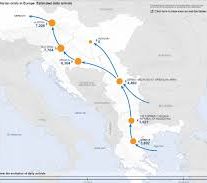
Western Balkans Route: really “closed”?
Migration 17 July 2017As a consequence of the record number of migrants arriving in Greece in 2015, the people who entered the EU in Greece tried to make their way via the former Yugoslav Republic of Macedonia, Serbia into Hungary and Croatia and then towards western Europe. This led to unprecedented numbers of migrants seeking to re-enter the EU through Hungary’s borders with Serbia. After Hungary completed the construction of a fence on its border with Serbia in September, the flow of migrants shifted to Croatia. Austria became a major transit route for people heading to Germany and received 90,000 asylum requests in 2015.
As a consequence, roadblocks and fences have been set up across the Balkans, which caused a backlog in Greece and other transit countries. Far fewer migrants are now reaching Austria via the Balkan routes – but people smuggling in this region continues.
This situation was again discussed in the news when 71 bodies decomposing in an abandoned lorry on an Austrian motorwaywere discovered few weeks ago. Four of those who lost their lives where children. Nine Bulgarians, an Afghan and a Lebanesewent on trial in Hungary for the lorry tragedy, accused of being part of a criminal smuggling network, and charged with murder.
This is just one example of facts showing that the Western Balkan Route is still used to reach countries in Western Europe, but that modus operandi has become more risky for migrants.
On Wednesday (21 June), the Friedrich Ebert Stiftung released a 26-page report, pointing out at the fragility of the situation. The report shows how the migrants’ route was diverted, with the southern entry point shifting from the Greek islands to Bulgaria’s land border with Turkey. While in 2015 migrants were stranded in Serbia, now they remain stranded in Bulgaria, as all the countries further West are securing their borders and pushing back the refugees, the report says. As a result, apart from Greece, Serbia and Bulgaria were the countries with the highest number of stranded asylum seekers at the end of 2016: 6,232 in Serbia and 5,534 in Bulgaria.
The report shows maps of illegal pushbacks taking place at the Bulgarian-Turkish border toward Turkey, and at the Bulgaria-Serbian border towards Bulgaria. Pushbacks are also taking place at the Serbia-Macedonia border in both directions, at the Hungarian-Serbia border toward Serbia, and at the Hungarian-Croat border towards Croatia. As a result, Bulgaria and non-EU member states Macedonia and Serbia find themselves with thousands of people who in fact don’t want to stay in those countries.


